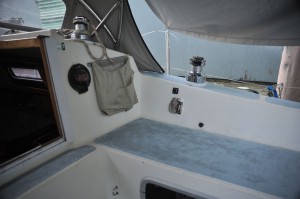The new shore power inlet is installed. Deciding the placement was difficult. It needed to be close enough to the service panel to avoid the requirement for additional circuit breakers. Placing it on the cockpit exterior would have interfered with rigging. Through the cabin top would have been ugly with no way to conceal the back of the inlet or the large electrical cable.
The coaming interior near the cabin bulkhead was the best compromise. An existing cutout in the cabin top provided good access to the coaming interior. This facilitated installation of backing plates and reaching the back of the inlet to tighten fasteners.
Helmut ended up doing most of the inlet installation. With SmartPlug inlet in hand, we went to Helmut’s large home shop where he fabricated an aluminum backing plate. At the boat, he made the cutout in the fiberglass with a two inch hole saw followed by a Fein Multimaster. We connected the three 10 gauge leads to the back of the inlet and inserted the inlet into the cutout. I held the inlet in place while Helmut reached inside the coaming to fit the backing plate and nuts. A couple additional 1 inch holes were needed through bulkheads to lead the cable to the service panel.
The galvanic isolator fit conveniently through the cabin top hole and ended up being located inside the coaming (still needs to be secured properly). The isolator is connected at the panel rather than inline at the inlet for ease of access. Wires are connected to the isolator leads and incoming ground lead using crimping, heat shrink butt connectors.
The new AC leads are temporarily connected to the existing AC panel and ground bus to provide usable power on the boat while waiting for the new AC panel to arrive. Theoretically this setup should work as before but with a safer connection to shore. However, after 15 minutes of running the battery charger and a space heater together something in the panel started producing a buzzing sound. The sound could have several possible causes including arcing, a breaker (or the main) close to its capacity, or a breaker gone bad. In any case it’s a sign that the old panel is not to be trusted.



